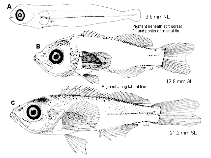| In preflexion larvae, relatively wide space (5-6 myomeres) separating anus and ventral pigment series, short pigment series dorsally on tail, and pectoral pigmentation; postflexion larvae similar to those of S. melanops, S. flavidus, and S. entomelas but differ from them in having a unique combination of 16 dorsal soft rays, 9 anal soft rays, and 18 pectoral fin rays; pelagic juveniles have broad bars and large blotch on first dorsal fin.
Pigmentation:
Pigmentation:
Preflexion: initially, dorsally and ventrally on gut, 1 anterior to anus, and about 15 in series on ventral margin of tail (from postanal myomere 5-6 through 16-18); at about 5.0 mm, on midbrain, nape, otic region, lower jaw, laterally on cleithrum, short series on dorsal margin of tail (from postanal myomere 9-10 through 18), and on pectoral fin blade (heavy on distal margin of blade).
Postflexion: by 12.8 mm, heavy on brain and opercle, some on snout, upper jaw, on dorsum (heaviest at second dorsal fin), ventrally on caudal peduncle, posteriorly on anal fin base, short series on lateral midline at caudal peduncle-hypural region, on posterior hypural margin, scattered on pectoral fin blade, and proximally on pelvic fins; by end of stage, postorbital patch, heavy on top of head and entire dorsum, beginning to cover epaxial region of body, and streak at lateral midline extending forward to trunk.
Pelagic juvenile: heavy dorsally on head; 2 diagonal streaks on cheek; broad bars below first dorsal, second dorsal, and at caudal peduncle; first dorsal fin covered and black blotch between 7th-12th spines; patches proximally on second dorsal fin. |
